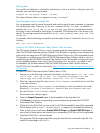The following identifying information is common to several objects:
• Ctlr—The controller for which metrics are being reported. This field shows the last four digits
of the controller serial number.
• Node—The array from which data has been collected.
• GroupID—The disk group to which the virtual or physical disk belongs.
Not all metrics that are available in the command line interface are available in Windows
Performance Monitor.
HP EVA storage array
The HP EVA storage array object provides information about the total workload on the array.
The counters are:
• Total Host Req/s—The total number (per second) of host-initiated read and write requests
to the controller pair.
• Total Host MB/s—The total rate (per second) at which data is read from and written to
the disk by the controller pair.
HP EVA storage controller
The HP EVA storage controller object provides information about controller processor and host
data transfer utilizations.
The counters are:
• % Processor Time—The percentage of time that the central processing unit on the controller
is active. A completely idle controller shows 0%. A controller saturated with activity shows
100%.
• % Data Transfer Time—Similar to % Processor Time except that it does not include time
for internal processes not related to host-initiated data transfers. For example, it does not
include time for sparing, leveling, snapclones, snapshots, replication traffic, virtual disk
management, or communication with other applications. The value is always equal to or less
than the % Processor Time counter and the difference is the amount of processor time engaged
in non-data transfer activity.
HP EVA virtual disk
The virtual disk object provides information about workload and performance for each virtual disk
on the array. Activity is reported separately for each controller accessing a virtual disk. The total
activity for each virtual disk is the sum of the reported activity for each controller. A virtual disk
may also be a snapshot, snapclone, or a DR group member. In the output, logical unit number
(LUN) is used interchangeably with virtual disk.
Virtual disks must be presented to a host to be seen by HP P6000 Performance Data Collector.
However, replication volumes on the replication system are visible without being presented. HP
P6000 Performance Data Collector also shows DR group membership with the virtual disk table
in the DRM Group column.
If the array controllers are active/standby, all activity to a virtual disk is through the active controller.
If the array controllers are active/active, one controller is preferred (the owning controller) but
requests can still be processed by the other controller (the proxy controller). In active/active
controllers, all host requests are logged by the receiving controller only, whether owning or proxy.
Thus, all request rate and data rate activity for a virtual disk is the sum of both controllers.
88 Monitoring array performance using HP P6000 Performance Data Collector


















